Anke Frohlich
Anke is a very good, very dedicated photographer who has been on many IPTs. She loves photographing birds in flight and in action. She often handholds the Sony 600mm f/4 for flight. Her style is to shoot wide and crop. She rarely uses even the 1.4X TC on her big lens. She spent a year photographing Flaco, the Eurasian Eagle Owl that was freed after living in captivity for many years in New York City’s Central Park Zoo. She worked almost exclusively at night most often using very long exposures and a cable release. You can see many of her excellent Flaco images on her Instagram account here. And you can check out related social media links and articles here.
Huge thanks to Anke for letting me share her fine work with you here on the blog.
Your Call?
Which two of Anke’s seven images are the strongest?
Which was the most challenging capture?
What’s Up?
I was down to the lake early today, Sunday 7 April 2024. After a very slow start, I located the three surviving crane chicks and worked them for a bit. I photographed an Osprey perched in the old eagle nest tree and one of the young eagles in flight. I will be creating the promised a9 iii picking your keepers video after breakfast. Whatever you opt to do, I hope that you also have a great day. Remember: happiness is a choice.
Don’t look now, but this blog post makes eight days in a row with a new educational post just for you.
Please, therefore, remember to use the B&H links that are found on most blog pages and to use the BIRDSASART discount code at checkout when purchasing your new gear from Bedfords to get 3% back on your credit card and enjoy free second-day air FedEx. Please, also, consider joining a BAA IPT. You will be amazed at how much you will learn!
If an item — a Delkin flash card, or a tripod head — for example, that is available from B&H and/or Bedfords, is also available in the BAA Online Store, it would be great, and greatly appreciated, if you would opt to purchase from us. We will match any price. Please remember also to use my B&H affiliate links or to earn 3% cash back at Bedfords by using the BIRDSASART discount code at checkout for your major gear purchases. Doing either often earns you free guides and/or discounts. And always earns my great appreciation.
|
|
|
This image was created by Anke Frohlich on one of the 2024 BIRDS AS ART Homer IPTs. She used the used the handheldSony FE 70-200mm f/2.8 GM OSS II lens with the Sony FE 1.4x Teleconverter (at 280mm) and The One, the Sony Alpha 1 Mirrorless Digital Camera.. The exposure was determined via Zebras with ISO on the Thumb Dial. ISO 4000: 1/3200 sec. at f/4 (wide open) in Manual mode. Tracking: Zone/AF-C with Bird-Eye/Face Detection performed perfectly. Image #1: Bald Eagle juvenile in flight by frozen waterfall |
Frozen Waterfalls
In 2024, it had been warm for weeks when we arrived and our favorite frozen waterfalls were all melted and missing. The captain and I put our heads together, explored some likely spots, and did OK. Anke is a skilled flight photographer and in addition, she is relentless. When she visualizes an image that she wants, she will stick with the situation until she gets the shot.
|
|
|
This image was created by Anke Frohlich on one of the 2024 BIRDS AS ART Homer IPTs. She used the Robus RC-5558 Vantage Series 3 Carbon Fiber Tripod/Levered-Clamp FlexShooter Pro-mounted Sony FE 600mm f/4 GM OSS lens and The One, the Sony Alpha 1 Mirrorless digital camera. ISO 1000: 1/6400 sec. at f/4 (wide open). Tracking: Zone/AF-C was active at the moment of exposure and performed perfectly. Be sure to click on the image to enjoy the larger version. Image #2 Pine Grosbeak male wheeling in flight |
The Real Thing
Anke created this image by tracking the bird in flight as it jumped off a perch. It is not one of those manually pre-focused spray and pray songbird flight shots. I do not think that images made with the latter technique should be considered photography as they are more like arts and crafts than art. Not that the spray and pray technique can produce some stunning images. Along with many thousands of instant-deletes.
|
|
|
This image was created by Anke Frohlich on one of the 2024 BIRDS AS ART Homer IPTs. She used the used the handheldSony FE 70-200mm f/2.8 GM OSS II lens (at 200mm) and The One, the Sony Alpha 1 Mirrorless Digital Camera.. The exposure was determined via Zebras with ISO on the Thumb Dial. ISO 3200: 1/2500 sec. at f/2.8 (wide open) in Manual mode. Tracking: Zone/AF-C with Bird-Eye/Face Detection performed perfectly. Image #3: Bald Eagle after a swing and a miss |
The 70-200mm f/2.8 Lenses
The 70-200mm lenses are incredibly useful on a Homer IPT. You could actually do the whole trip with just that one lens. At times you may want to add the 1.4X TC or even a 2X TC. Note that the Canon RF 70-200mm does not accept any teleconverter.
|
|
|
This image was created by Anke Frohlich on one of the 2024 BIRDS AS ART Homer IPTs. She used the used the handheldSony FE 70-200mm f/2.8 GM OSS II lens (at 178mm) and The One, the Sony Alpha 1 Mirrorless Digital Camera.. The exposure was determined via Zebras with ISO on the Thumb Dial. ISO 800: 1/3200 sec. at f/2.8 (wide open) in Manual mode. Tracking: Zone/AF-C with Bird-Eye/Face Detection performed perfectly. Image #4: Bald Eagle jumping up |
Listen to the Leader
I saw a really good situation with the snow-covered slope and a distant background and called everyone within earshot over. Several eagles cooperated nicely. Notice how beautifully and evenly the light reflected off the snow lit the eagle’s underwings.
|
|
|
This image was created by Anke Frohlich on one of the 2024 BIRDS AS ART Homer IPTs. She used the used the handheldSony FE 70-200mm f/2.8 GM OSS II lens (at 153mm) and The One, the Sony Alpha 1 Mirrorless Digital Camera.. The exposure was determined via Zebras with ISO on the Thumb Dial. ISO 1600: 1/2500 sec. at f/2.8 (wide open) in Manual mode. Tracking: Zone/AF-C with Bird-Eye/Face Detection performed perfectly. Image #5: Bald Eagle upside down before dive |
Oh What Fun!
When the wind is just right, everyone enjoys the challenge of trying for the perfect upside-down eagle image. Even with my expert coaching :-), it takes some time to get the rhythm down pat. I urge folks to study the flight patterns of the birds. Those varied of course with the speed and direction of the wind. Folks in both groups had a ton of fun comparing their best upside down shots on their rear monitors and learned a lot in the process.
Best advice: don’t get greedy: zoom out to avoid clipping wings.
|
|
|
This image was created by Anke Frohlich on one of the 2024 BIRDS AS ART Homer IPTs. She used the used the handheldSony FE 70-200mm f/2.8 GM OSS II lens (at 178mm) and The One, the Sony Alpha 1 Mirrorless Digital Camera.. The exposure was determined via Zebras with ISO on the Thumb Dial. ISO 4000: 1/2500 sec. at f/2.8 (wide open) in Manual mode. Tracking: Zone/AF-C with Bird-Eye/Face Detection performed perfectly. Image #6: Bald Eagle in predawn flight with pink purple blue earth shadow sky background |
Early to Rise
When the weather is decent, my boat is always the first out of the harbor. And if I see stars when I wake and peek out the window, I call the captain and we arrange to leave even earlier so that we can try for the blue/pink/purple earth shadow sky colors. Near the end of the first IPT, we had one perfect morning. Conditions with little to no wind are ideal as the calm water in the coves can reflect the sky colors.
|
|
|
This image was created by Anke Frohlich on one of the 2024 BIRDS AS ART Homer IPTs. She used the used the handheldSony FE 70-200mm f/2.8 GM OSS II lens with the Sony FE 1.4x Teleconverter (at 280mm) and The One, the Sony Alpha 1 Mirrorless Digital Camera.. The exposure was determined via Zebras with ISO on the Thumb Dial. ISO 800: 1/2500 sec. at f/4 (wide open) in Manual mode. Tracking: Expand Spot/AF-C with Bird-Eye/Face Detection performed perfectly. Image #7: Sea Otter with pup |
Sea Otters
Over the years, on occasion, we have had some good chances on Sea Otters in the various coves across Kachemak Bay from Homer. But our best chances almost always occur as we are returning to the dock on a cloudy day. Adults with pups resting on their breasts always get everyone excited. The pups often have their heads buried in mom’s fur; Anke, however, did well here with two good head angles.
No Homer IPT Price Increase!
Despite that fact that the hourly boat fee has been increased by 33%, I have decided not to raise the price of the 2025 Homer IPTs. Note that similar trips with 40% less time on the boat cost $5800!
2025 Homer/Kachemak Bay Bald Eagle IPTs
IPT #1: FRI 14 FEB 2025 through the full day on TUES 18 FEB 2025. Five days/20 hours on the boat: $5500.00. Limit 5 photographers/Openings 2.
IPT #2: WED 19 FEB 2025 through the full day on SUN 23 FEB 2025. Five days/20 hours on the boat: $5500.00. Limit 5 photographers/Openings 1.
Register for both trips to maximize your travel dollars and enjoy a $1000 discount while you are at it. In 2024, three of the five participants did both trips!
This trip features non-stop flight photography as well as many opportunities to create both environmental and point-blank portraits of one of North America’s most sought-after avian subjects: Bald Eagle (Haliaeetus leucocephalus). Other reliable subjects will include Sea Otter, Glaucous-winged and Short-billed (formerly Mew) Gulls.
In addition, we should see Common Murre, Black Guillemot, Pelagic Cormorant, two or three species of loons, and a smattering of ducks including two species of merganser, all three scoters, Common and Barrow’s Goldeneyes, Bufflehead, Harlequin, and Long-tailed Ducks. Close-range photographic chances for these species will require some good luck. Some of these species, especially when in flocks, can, however, often be used effectively when pleasing creating bird-scapes.
If we need to be out early, we will be the first boat out. If the conditions are great, we will stay out. And when there is a chance for sunset silhouettes, we will be in the right spot.
We will be traveling through gorgeous wilderness country; landscape and scenic opportunities abound.
Also featured is a professional leader, often referred to as the world’s most knowledgeable bird photography trip leader and instructor. He is conversant in Canon, Nikon, and Sony. You will learn practical and creative solutions to everyday photographic problems. You will learn to see the shot, to create dynamic images by fine-tuning your compositions, to best utilize your camera’s AF system, and how to analyze the wind, the sky conditions, and the direction and quality of the light. This is one of the very few trips Homer trips available where you will not be simply put on the birds and told to have fun. You will learn to be a better photographer.
|
|
All images from Kachemak Bay in 2022! |
What You Will Learn
You will learn practical and creative solutions to everyday photographic problems. You will learn to see the shot, to create dynamic images by fine-tuning your compositions, to best utilize your camera’s AF system, and how to analyze the wind, the sky conditions, and the direction and quality of the light. This is one of the very few trips Homer trips available where you will not be simply put on the birds and told to have fun. You will learn to be a better photographer.
You will learn to get the right exposure when it is sunny, when it cloudy-bright, when it is cloudy, when it is cloudy-dark, or when it is foggy. Not to mention getting the right exposure when creating silhouettes. You will learn to make pleasing blurs working in manual mode and to create silhouettes working in Shutter Priority mode. Most importantly, you will learn to pick your best flight photographs from tens of thousands of images.
You will enjoy working with the best and most creative boat captain on his sturdy, photography-spacious, seaworthy, open-deck watercraft.
There will be only five photographers (not the usual six), plus the leader.
Small group Photoshop, Image Review, and Image Critiquing sessions most days.
|
|
All images from Homer or Kachemak Bay, AK |
What’s Included
One four hour or two two-hour boat trips every day (weather permitting), all boat fees and boat-related expenses (excluding tips), ground transportation to and from the dock and back to the hotel each day, in-the-field instruction and guidance, pre-trip gear advice, small group post-processing and image review sessions, and a thank you dinner for all well-behaved participants.
What’s Not Included
Your airfare to and from Homer, AK (via Anchorage), the cost of your room at Land’s End Resort, all personal items, all meals and beverages, and tips for the boat captain and/or the first mate.
Important Notes
We toss frozen herring chunks to bring the eagles into photographic range. The late Jean Keene, the Eagle Lady, fed the eagles in Homer for many decades and brought the population back from the brink of extinction.
On great days, the group may wish to photograph for more than four hours. If the total time on the boat exceeds 20 hours for the five-day trips the group will share the additional expense at a rate of $300.00/hour. The leader will pay for the bait.
Some folks may wish to rent their own vehicle to take advantage of local photographic opportunities around Homer. In 2024 those included Moose, Sea Otter, a variety of sea ducks in the harbor, and Great Grey and Short-eared Owl.
Deposit Information
A $3000 non-refundable deposit/trip is required. You may pay your deposit with credit card or by personal check (the latter made out to BIRDS AS ART) and sent via US mail only to Arthur Morris. PO Box 7245. Indian Lake Estates, FL 33855. Your balance, due 90 days before the date of departure, is payable only by check.
In Closing
I have been going to Homer off and on for close to two decades. Every trip has been nothing short of fantastic. Many folks go in mid-March. The earlier you go, the better the chances for snow. The only way to assure that you are on the best of these two trips is to sign up for both of them. If you have any questions, or are good to go for one or both of these great trips, please let me know via e-mail or give me a call on my cell phone at 863-221-2372.
Typos
With all blog posts, feel free to e-mail or to leave a comment regarding any typos or errors.

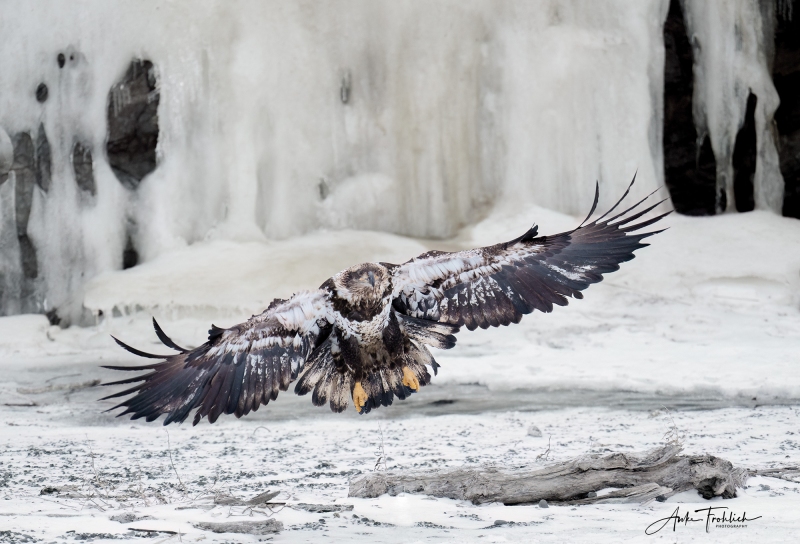
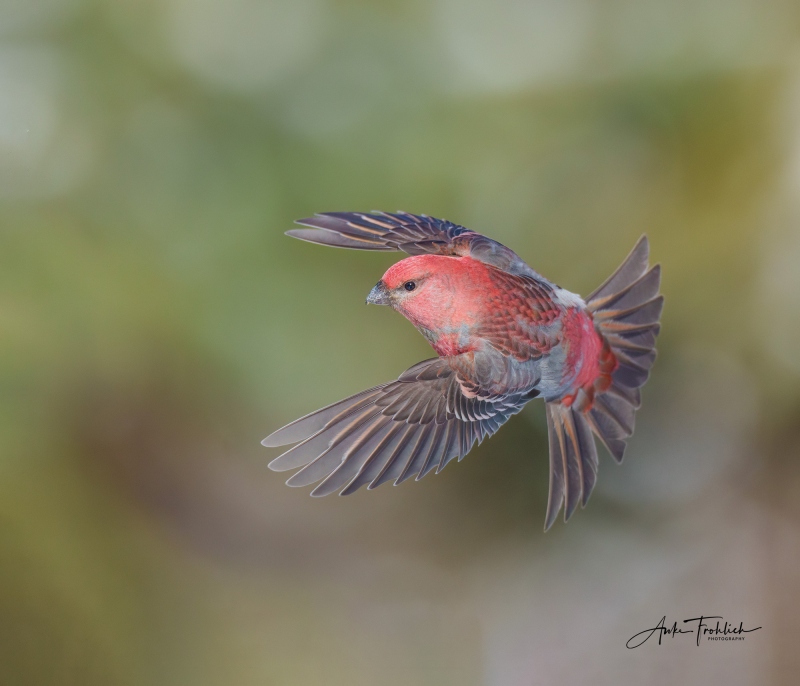
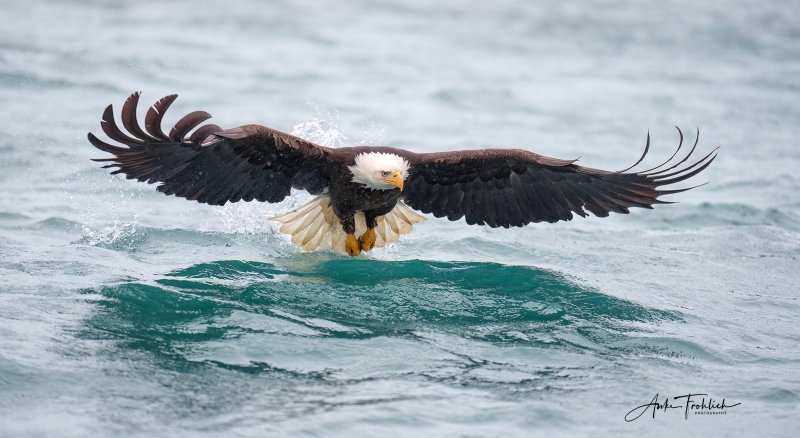
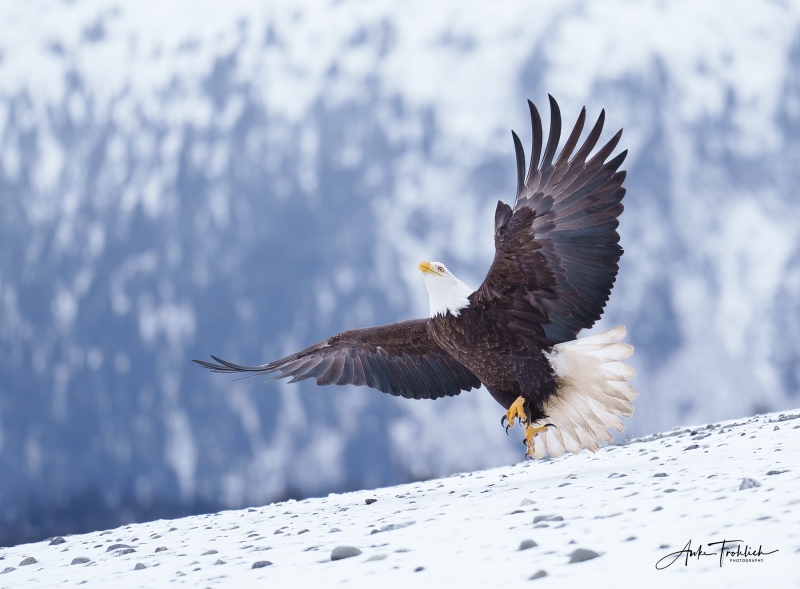
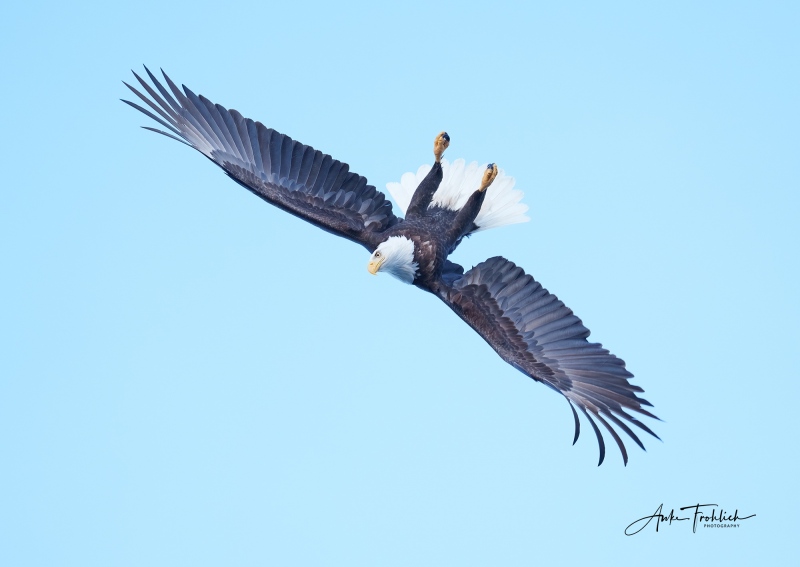
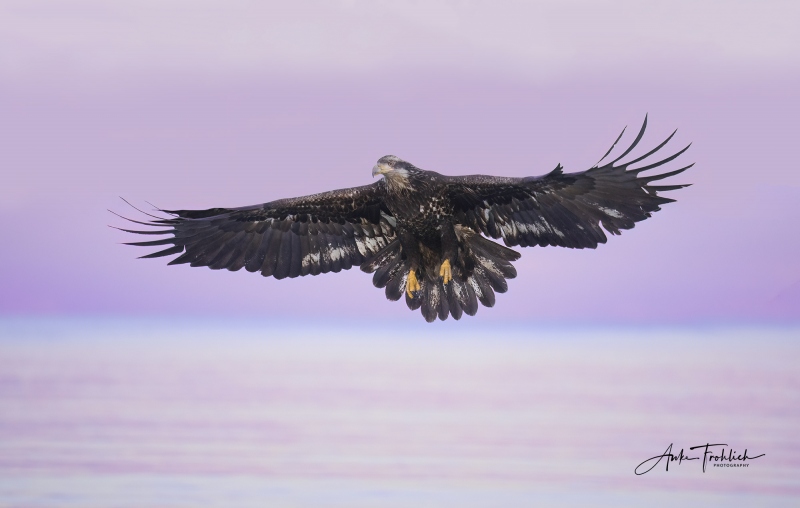
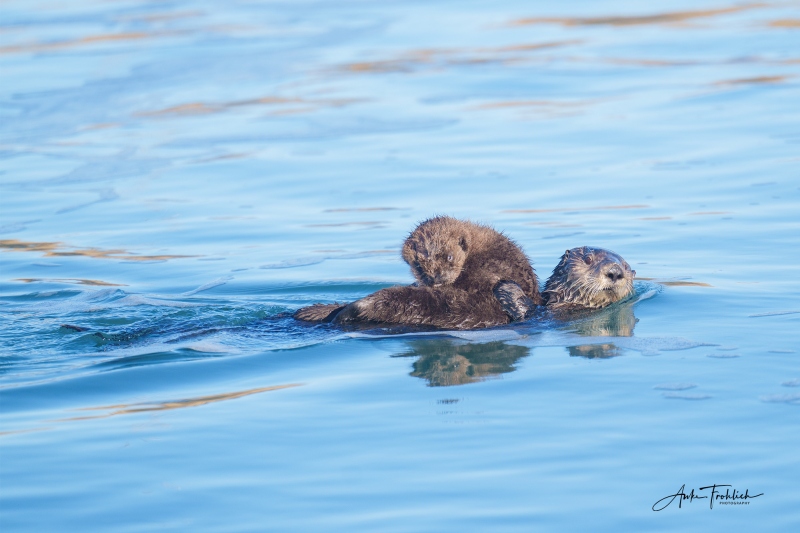
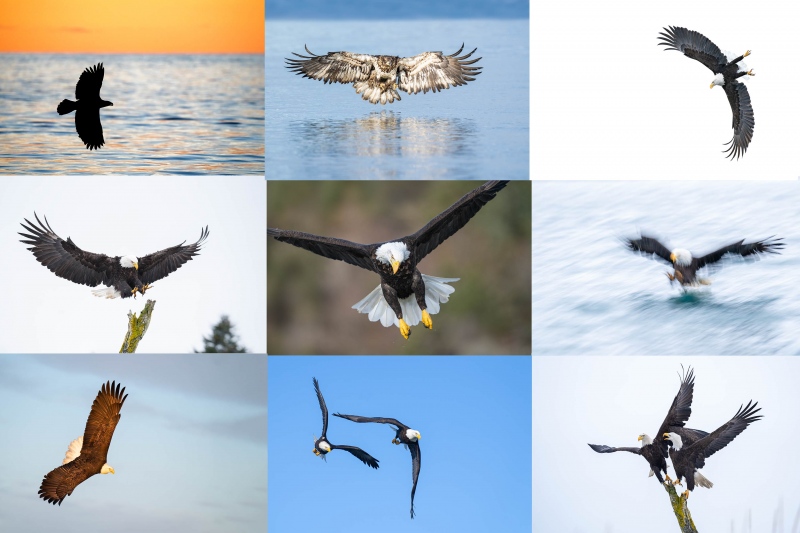
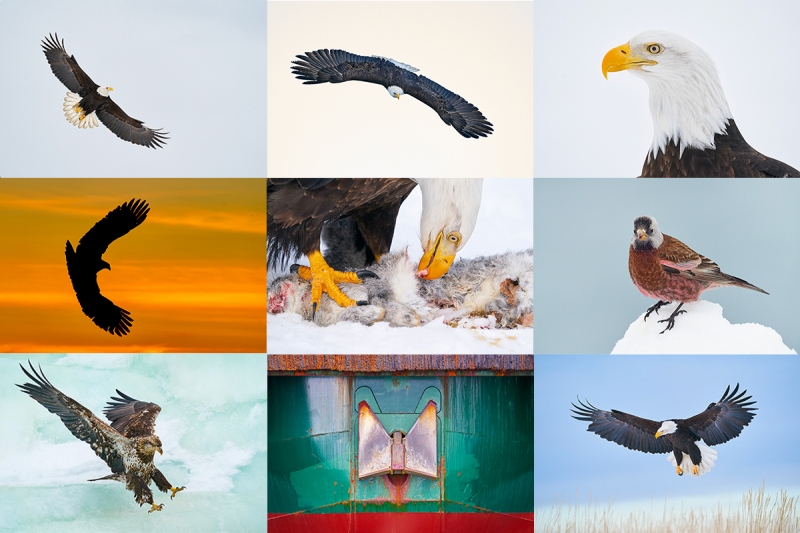













#6, then #2. The background of #6 alone rules the day. Thanks to both of you. The diving eagle upside down would to me be a difficult capture. Keep on keepin’ on.
Hi, Artie and Anke. Great images. I think the most challenging capture and one of my favorites among the 7 images is the pine grosbeak in flight. Grosbeaks are much smaller and quicker than eagles or otters and I think much more challenging to capture in flight. This image has lovely color and composition, too. My other favorite is the eagle that swung and missed; I love the shadow of green water.
I don’t know how you draw the line between spray and pray and not spray and pray. I would guess Anke was holding the shutter button down for all the flight shots. If you track the birds intelligently then spraying and praying gets you better images and more keepers than otherwise.
By songbird spraying and praying I am referring to a technique where you prefocus manually on a spot to the side of a perch where a songbird might lands. As you see a bird approaching, you press the cable release and hold it, hoping to get very, very, very lucky. AF is NOT ACTIVE. Getting a sharp image is 100% lucky (aside from setting your gear up properly and reading the wind).
Anke was using autofocus and tracking the bird in flight. And yes, that requires a very high degree of skill. Much more skill than I have.
with love, artie
Thanks for the explanation, Artie. I’ve seen some pretty fine images you have made of birds in flight. I think you have the skill required.
Thanks David. But rarely with songbirds if ever 🙂
a